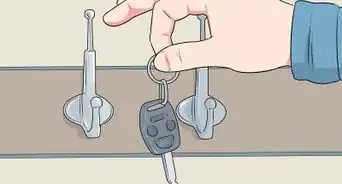This article was co-authored by Archana Ramamoorthy, MS. Archana Ramamoorthy is the Chief Technology Officer, North America at Workday She is a product ninja, security advocate, and on a quest to enable more inclusion in the tech industry. Archana received her BS from SRM University and MS from Duke University and has been working in product management for over 8 years.
There are 12 references cited in this article, which can be found at the bottom of the page.
This article has been viewed 39,761 times.
Giving back is an important way to stay engaged in our community and to be a good citizen. There are ways to give back to your community even when you are low on financial funds or resources. Volunteering and giving back your time is a great way to invest in the well-being of your community. Giving back to causes and organizations that you care about will often benefit everyone involved!
Steps
Finding Ways to Give
-
1Identify causes that you care about. If you are interested in supporting your community in a specific way, you can tailor your volunteering and charitable giving based on causes.
- Usually, charitable organizations have a mission that is related to one particular cause. If you feel called to support an organization based on their mission, this is a good place to start.
- Other organizations, like community centers, do not have a specific cause that they are working towards. They tend to be interested in generally supporting and benefiting the members of the community.
- Whether you choose an organization that is dedicated to a specific cause or not, this is a good way to start thinking about your charitable actions.
-
2Find an organization. Now that you have identified causes that you are interested in supporting, you can begin to search for organizations.
- Search with organizations that are aligned with the causes that you care about. For example, you could search “Domestic violence organizations” with your zip code or city and see if there are charities in your area that you can support.
- Ask friends and family about what organizations they support. They may be supporting an organization that you hadn’t come across in your search that you connect with.
- Visit organization’s websites. The majority of charities will have a web presence and most will list what sort of support they need (ex. clothing donations, food donations, monetary).
EXPERT TIPArchana Ramamoorthy is the Chief Technology Officer, North America at Workday She is a product ninja, security advocate, and on a quest to enable more inclusion in the tech industry. Archana received her BS from SRM University and MS from Duke University and has been working in product management for over 8 years.Chief Technology Officer, Workday
 Archana Ramamoorthy, MS
Archana Ramamoorthy, MS
Chief Technology Officer, WorkdayLook for an organization that fits your values and your schedule. Archana Ramamoorthy, the Director of Technology Product Management at Workday says: "When I was looking for an organization to volunteer with, first I looked for local programs and I narrowed them down based on their causes. I made a list of about 4 or 5, then I picked the one that was the most open to having volunteers. Also, for me, weekends were the best time to volunteer, so I looked for the places that had opportunities that matched my schedule."
-
3Rate the organization. Some charities are better, more reputable, and help more people than others. You should take some time to make sure that this organization will distribute your donations to the people who need them.[1]
- Before you donate your time, resources, and money to an organization it is important to consider its reputation and how effective it is.
- Use a charity search to look for reviews and ratings of the different organizations that you are considering supporting.[2]
- Smaller and local organizations may not be searchable. You should ask around your community and social network to see if anyone has had any negative experiences with that organization.
-
4Look at what your community needs. As you look at ways to give back, you will learn more about the needs of your community and how already established organizations or programs support those needs. You may notice that there is a gap in the services offered in your area, or that organizations aren't reaching certain groups or areas.
- Start an organization or program. You may be passionate about promoting literacy and helping kids love to read, and notice that your local school district doesn't offer any after-school programs dedicated to reading. You could start a program that promotes causes that you care about.
- If you decide that you'd like to start an organization or program in your area, it may be helpful to partner with an established organization or community center in your area. That way, you can tap into their resources and expand their programming.
- Look for other people that share your interests and form a group that dedicates their time to working towards that cause.
- Organize with others to start a club, program, event or organization that you believe will give back to your community. You can use this as an opportunity to educate others about the cause, to raise funds, and to raise awareness.
-
5Think local or think global. Giving back to the community can also mean giving back to the global community, or you could decide to keep your donations closer to home.
- You may identify national or international organizations that align with the causes that you care about.
- If you live in an area that a global organization works in, your support for that organization would also indirectly support your own community.
- You can also limit your search for an organization to your town or county and keep your focus local.
Giving with Your Time
-
1Donate your human capital. Your human capital refers to the things that make you the person that you are. In respect to charitable giving, this could mean the skill sets that you have, the time you have, and the gifts you have.
- You can choose to donate your time in a skill specific role. For example, if you are a lawyer, you can offer pro bono legal consulting to women’s shelters, to domestic violence organizations, or to counsel troubled teenagers.[3]
- You can also give your time as a volunteer. This could mean volunteering for an hour a week or establishing a long-term relationship with an organization.
- Giving your gifts would allow you to use a special skill, or gift, that you have to help others. For example, if you have a compassionate heart for animals you could volunteer at an animal shelter to socialize the animals.
-
2Make a schedule. Making a time commitment to an organization will make you much more likely to follow through on your commitment of giving your time.
- You can start off as slowly as you’d like. You can start by giving an hour or two of your time volunteering at an organization during the month.
- Ask you become more engaged with the organization and your community, you may find that you can give more of your time.
- Make your volunteering a family activity with your significant other and children. This is a great way to teach children about generosity, helping others, charity, and their community.[4]
-
3Ask friends and family to join you. When you’ve found an organization that you care about, you should share your passion with the people you care about.
- Use charitable events as a time to spend with your friends and family. For example, you could all sign up to run a 5k that supports an organization that you care about.
- Encourage others to join you when you volunteer. It can be harder to ask someone to give their money to an organization, but people may be more receptive to spending time volunteering with you instead.
- Sharing the great work that an organization does with others helps to grow the organization so it can benefit more people!
- Since your friends and family are part of your community, you can all give back to the community together.
-
4Make giving back a habit. Giving back to your community is rewarding for you, for your community, and for the people that you are helping. It can be tempting to associate giving with the holidays, but these organizations need help year round.
- When giving becomes a habit, rather than a special event, you are more likely to think about ways that you can help others and give back.[5]
- As you continue to give back to your community, you will be able to see the direct effects of your participation over time! This is a rewarding feeling and encourages you to continue to give back. like new packages of disposable razors, menstrual products, toothpaste, and more.
-
5Become involved politically. Local politics exert significant influence over a community, and becoming engaged politically can allow you to make a direct impact on the services, funding, and manpower available for your area.
- You can lobby for causes that you care about by reaching out to local and state politicians and telling them why you care about this cause. This can be especially important if there is a bill that is related to your interests up for vote.
- Running for local office is a great way to become engaged in politics and to make a direct impact on your community.[6]
- Run for an elected position within an organization. Many interest groups, community centers, charities, school boards, and non-profits elect officers to complete different tasks within their group. By running for an elected office, like President or Secretary, you can directly involve yourself in the day-to-day workings of an organization that you care about.
-
6Fundraise for organizations. Most organizations and programs receive their funding from public and private sources, including donations from individuals like you. Raising funds for a group that you care about helps that organization to continue the work that they do, expand to reach more people, and to make more of an impact.
- There are a lot of different ways that you can raise money, including asking friends and family, selling items like baked goods or products related to the organization, holding a charity fundraiser, auctioning off items, or partnering with a local restaurant.[7]
Giving with Your Resources
-
1Assess what you can give. If you have decided to donate your physical resources to an organization, you should take stock of what you can give.
- It is completely okay if you feel that you don’t have much to give. Small donations can still have a meaningful impact on the organization and the people they help.[8]
- Go through your belongings and identify anything that you could do without. This could be books, old electronics, clothing, furniture, tools, and more.
- Create a pile of things that you would like to donate. You can divide this pile up between different organizations, as long as they are willing to accept these items.
-
2Create a budget with giving in mind. Budgeting is already an important part of our financial health. When you modify your budget to include a section where you set aside money to donate, you can commit to giving financially.[9]
- Your employer may offer matching contributions for charitable giving. This means that if you decide to give $100, your company will also give $100, so the charity receives $200.
- Use a search tool to see what sort of donations that your employer will match. You can also speak to a member of the Human Resources Department to get this information.[10]
- Set aside a certain amount of money each month that you can commit to giving. Some charities will allow you to make automatic donations on a monthly basis, so you don’t have to remember to give at a certain time.
-
3Donate your physical resources. When you’ve collected things that you know that could be used by someone else, you need to make sure that they are gently used, functional, and clean.
- Call the organization or check their website to see if they will accept the item. For example, some organizations will accept appliances like fridges while others do not.
- Some organizations will offer to pick up your donation. This is especially helpful for large items like furniture that can be difficult to transport.[11]
-
4Know what to donate. There are many different things that you can donate.[12] Here is a list of some different items that can help you get started:
- Clothes
- Rewards points that you’ve accumulated on your rewards credit card or from airline miles.
- Non-perishable food
- Glasses
- Old cell phones and old electronics
- Furniture
- Books
- Toiletries
References
- ↑ https://www.charitywatch.org/home
- ↑ http://www.charitynavigator.org/
- ↑ https://hbr.org/2013/02/corporations-donate-your-skill
- ↑ http://www.parents.com/parenting/money/donate-to-charity/9-ways-to-teach-your-child-about-charity-/
- ↑ http://www.cnbc.com/2013/10/17/teaching-kids-charity-skip-the-soup-kitchen-trip.html
- ↑ http://howtorunforoffice.org/
- ↑ http://www.easy-fundraising-ideas.com/
- ↑ https://mic.com/articles/131148/even-if-you-re-broke-you-can-still-give-back-here-s-how#.wXwiou4iK
- ↑ http://www.moneycrashers.com/give-back-be-charitable-budget/































